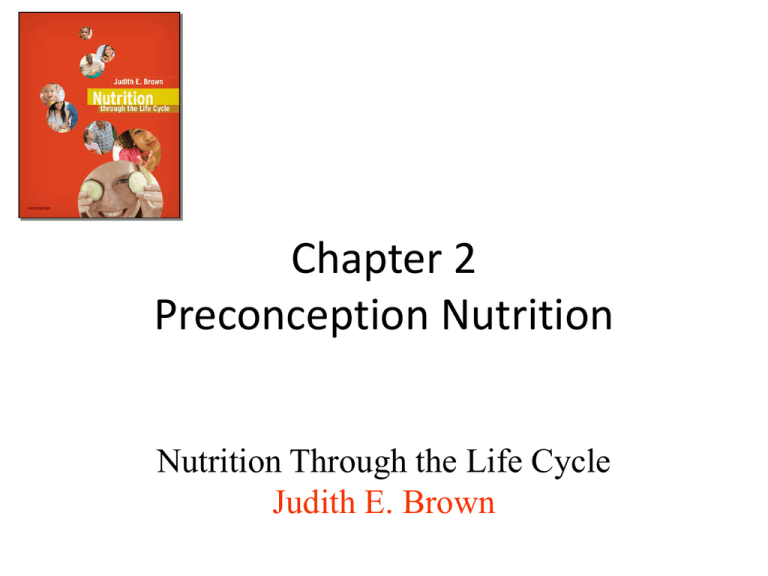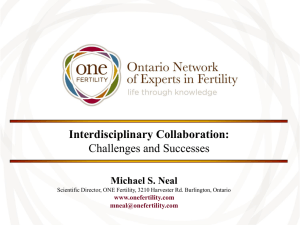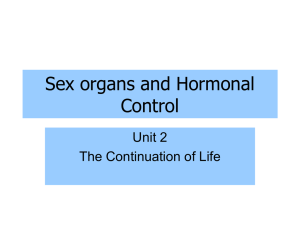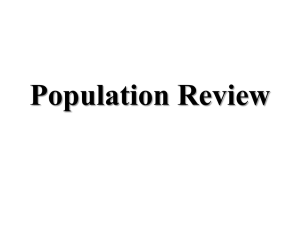chapter2 - csulancb12
advertisement

Chapter 2 Preconception Nutrition Nutrition Through the Life Cycle Judith E. Brown Preconception Overview: Infertility • ~15% of couples are infertile • 40% of couples diagnosed as “infertile” will conceive within 3 years without use of technology • Healthy couples have a 23% to 30% chance of conception within a given menstrual cycle Preconception Overview: Miscarriage • Miscarriage: Loss of conceptus in 1st 20 weeks of pregnancy • Causes of miscarriages: – Defect in fetus – Maternal infection – Structural abnormalities of uterus – Endocrine or immunological disturbances Preconception Overview: Subfertility • Subfertility: Reduced level of fertility characterized by unusually long time for conception • ~18% of couples are subfertile • Examples: – Having multiple miscarriages – Sperm abnormalities – Infrequent ovulation 2010 Nutrition Objectives for the Nation Related to Preconception Reproductive Physiology • Development of female & male reproductive systems – Begins during first months after conception & – Continue to grow & develop through puberty • Capacity for reproduction – Establishes during puberty when hormonal changes stimulate maturation of reproductive system Reproductive Physiology: Ova and Women • Women born with life-time supply of ~7 million immature ova • ~400-500 ova will mature & be released during fertile years Reproductive Physiology: Ova and Women • Chromosomes in ova – May be damaged by – Oxidation – Radioactive particle exposure – Aging • Women >35 years more likely to have disorders related to chromosomal defects than younger women Reproductive Physiology: Sperm and Men • Sperm production begins during puberty, decreases somewhat after age 35 with production continuing to old age Hormonal Effects During the Menstrual Cycle • Gonadotropin-releasing hormone (GnRH) – Stimulates pituitary to release FSH and LH • Follicle-stimulating hormone (FSH) – Stimulates maturation of ovum & sperm • Luteinizing hormone (LH) – Stimulates secretion of estrogen, progesterone, & testosterone Hormonal Effects During the Menstrual Cycle • Estrogen – Stimulates release of GnRH in follicular phase & follicle growth & maturation of follicle – Stimulates vascularity & storage of glycogen & other nutrients within uterus • Progesterone – Prepares uterus for fertilized ovum, increases vascularity of endometrium, & stimulates cell division of fertilized ova Two Phases of Menstrual Cycle • Follicular Phase—(first half of menstrual cycle) – Follicle growth & maturation – Main hormones: GnRH, FSH, estrogen, & progesterone • Luteal Phase—(last half of menstrual cycle) – After ovulation – Formation of corpus luteum – in estrogen & progesterone stimulate menstrual flow – Postaglandins & cramps Changes in the Ovary and Uterus Male Reproductive System • Interactions among hypothalamus, pituitary gland, and testes • Androgens — Testosterone • Sperm are stored in the epididymis & released in semen Sources of Disruptions in Fertility • • • • • • Adverse nutritional exposure Contraceptive use Severe stress Infection Tubal damage or other structural damage Chromosomal damage Factors Related to Altered Fertility Nutrition-Related Disruptions in Fertility • • • • • Undernutrition Weight loss Obesity High exercise levels Intake of specific foods & food components Undernutrition and Fertility • Chronic undernutrition – Primary effect: birth of small & frail infants with high likelihood of death in the first year of life • Acute undernutrition – Associated with a dramatic decline in fertility that recovers when food intake does Body Fat and Fertility • Decreased fertility seen with low or high body fat due to alterations in hormones • Estrogen & leptin – Levels increased with high body fat & reduced with low body fat – Both extremes lower fertility • Infertility lower with BMI <20 or >30 Weight Loss and Fertility in Females – Weight loss >10-15% of usual weight decreases estrogen – Results in amenorrhea, anovulatory cycles, & short or absent luteal phases – Treatment with fertility drug Clomid not effective in underweight women Weight Loss and Fertility in Males – Studies from World War II showed 50% decrease in male fertility during starvation – Sperm viability & motility decrease with wt. 10 to 15% <normal & cease at wt >25% < normal Exercise and Infertility • Adverse effects of intense physical activity – Delayed age at puberty – Lack menstrual cycles – Appear to be related to hormonal and metabolic changes – Related to caloric deficits – Reduced levels of estrogen – Low levels of body fat – Decreased bone density Diet and Fertility • Diet may impact hormones • Main dietary practices are vegetarian diets, low fat intake, high intakes of dietary fiber, soy, caffeine, & alcohol Oxidative Stress, Antioxidant Status, and Fertility • Oxidative stress in men – Decreases sperm motility – Reduces ability of sperm to fuse with an egg • Oxidative stress in women – Harm egg and follicular development – Interfere with corpus luteum function – Interfere with implantation of the egg. Oxidative Stress, Antioxidant Status, and Fertility • Antioxidants. – Vitamin E – Vitamin C – Beta-carotene – Selenium • Found in vegetables and fruits. • Protect cells of the reproductive system, including eggs and sperm. Oxidative Stress, Antioxidant Status, and Fertility • Zinc status and Fertility in Men. – Plays important roles • In the reduction of oxidative stress • In sperm maturation • In testosterone synthesis – Has been investigated for potential role in infertility Plant Foods and Fertility • Low-fat, high fiber linked to reduced estrogen & irregular periods • Isoflavones (from soy) decrease levels of gonadotropins, estrogen, & progesterone Preconception Iron Status, Fertility, & Pregnancy Outcome • Rate of infertility lower in women who use iron supplements or iron from plant foods • Pre-pregnancy iron deficiency linked to preterm delivery & low iron status of infant • ~1/2 of U.S. women enter pregnancy with inadequate iron stores Caffeine and Fertility • Caffeine appears to prolong time to conception • Daily caffeine intake & reduction in conception is: – 300 mg results in ~27% – 500 mg results in ~50% Alcohol and Fertility – Alcohol may decrease estrogen & testosterone levels or disrupt menstrual cycles – Studies on weekly drinks consumed show: • 1-5 drinks 39% in conception • >10 drinks 66% in conception Other Factors Contributing to Infertility in Males – Antioxidant nutrients • Protect sperm from oxidative damage – Vitamin D—Low status related to infertility – Alcohol intake—toxic effect on testes – Heavy metal exposure • Lead—impacts testes & sperm • Mercury—decreases sperm & semen – Halogens Other Factors Contributing to Infertility in Males – Glycols—from antifreeze – Hormones • synthetic estrogens, DDT, PEs, PCBs – Heat • sperm count can be reduced by elevating the temperature of the scrotum and testes – Steroid abuse • side effects include atrophy of testicles, absence of sperm, and decreased libido Nutrition-Related Side Effects of Contraceptives Other Preconceptual Nutrition Concerns • Very-early-pregnancy nutrition exposures • Folate status prior to conception – Neural tube defects • Recommended dietary intakes for preconceptional women Nutritional Disruptions MyPyramid Recommendations for Preconceptional Women Model Preconceptional Nutrition Programs • Preconceptional benefits of WIC • Decreasing iron deficiency in preconceptional women in Indonesia • Preconception care: Preparing for pregnancy CDC’s Preconceptional Health Initiative • Recommends that primary health care visits include: – Preconception health & pregnancy outcome education – Screening for vaccination, weight, iron & folate status – Assessment of alcohol use – Management of diabetes & celiac disease Another CDC Recommendation “Each woman, man, & couple should make a reproductive life plan that includes whether & when they want to have children & how they will maintain their reproductive health.” Centers for Disease Control & Prevention, 2006 Nutrition Programs and Services Delivery Before Pregnancy • Recently developed nutrition care standards – By the American Dietetic Association – Called “Nutrition Care Process” • Part of new technology-based systems –To facilitate health-services delivery –Cost evaluation –Electronic charting –Coding and outcome measurement Nutrition Programs and Services Delivery Before Pregnancy • The Nutrition Care Process Step 1: Nutrition assessment Step 2: Nutrition diagnosis Step 3: Nutrition intervention Step 4: Nutrition monitoring and evaluation See Table 2.10 for summary Suggested Readings • Before Your Pregnancy – A 90-Day Guide for Couples on How to Prepare for a Healthy Conception. By Amy Ogle, MS,RD and Lisa Mazzullo, MD • Integrated Perinatal Health Framework A Multiple Determinants Model with a Life Span Approach by Dawn P. Misra, PhD, Bernard Guyer, MD, Adam Allston, MPH Am J Prev Med 2003;25(1) Posted on Blackboard






